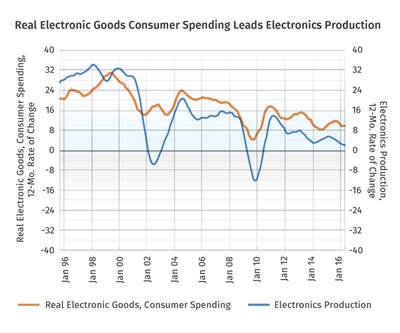Appliance Growth Slowing
Current growth rate in production is strong, but the dip in housing permits could change things.
Since May 2012, appliance production has grown in all but about 12 months. In our last update in October, we noted the leading indicators were pointing in a positive direction for the industry.
But the indicators have turned in the last six months. Here’s what’s going on:
Real 10-Yr Treasury Rate. The real (inflation-adjusted) 10-yr U.S. Treasury bond interest rate was 0.92% in February, which was a slight decline from last month. This was the first month below 1% since November, and it was the lowest rate since October. The nominal rate currently was 242 basis points (2.42%), which was virtually unchanged from last month. But the rate of inflation rose to its fastest rate since February 2012. In February 2017, inflation was above 2.5% for the second straight month. Increasing inflation is limiting the rise in the real 10-yr Treasury rate even though the nominal rate has increased (the real rate is the nominal rate minus inflation). The year-over-year change in the real rate increased to -53 basis points (-0.53%). That was the fourth straight month of an increase and the highest it has been since May 2016.
The interest rate is an extremely important indicator for the appliance industry because of its significant impact on the housing market. Generally, a lower rate either encourages refinancing of mortgages, providing cash for home improvements, or it makes the monthly payment of a new mortgage lower, which tends to spur activity in the market. Either tends to lead to purchases of new appliances.
Housing Permits. There were 84,500 housing permits filed in February 2017. This was the lowest level for permits since January 2016. Compared with one year ago, housing permits were unchanged, which was the second time in three months that permits did not grow. The annual rate of growth decelerated to 0.3%, which was the slowest since October 2011.
Housing permits tend to lag changes in the real 10-yr Treasury rate by about one year. Since October 2016, the change in the interest rate has been moving in a negative direction for housing permits. Therefore, I expect the annual change in housing permits to contract at some point in 2017.
Appliance Industrial Production. Despite the extended period of growth since May 2012, the actual level of appliance production is still at the bottom of the production levels from 1994 to 2007. That shows what a toll the industry took as a result of the popping of the housing bubble about 10 years ago.
In February, appliance production was up 2.4% from where it was one year prior. That was the slowest rate of month-over-month growth since March 2016. The rate of growth has slowed significantly since last fall. As a result, the annual rate of change in appliance production (see graph) grew at a slightly slower rate in February. While the current growth rate is quite strong, I expect the growth in appliance production to slow throughout 2017.
ABOUT THE AUTHOR: Steven Kline Jr. is part of the fourth-generation ownership team of Cincinnati-based Gardner Business Media, which is the publisher of Plastics Technology. He is currently the company’s director of market intelligence. Contact: (513) 527-8800 email: skline2@gardnerweb.com; blog: gardnerweb.com/economics/blog
Related Content
Foam-Core Multilayer Blow Molding: How It’s Done
Learn here how to take advantage of new lightweighting and recycle utilization opportunities in consumer packaging, thanks to a collaboration of leaders in microcellular foaming and multilayer head design.
Read MoreABC Technologies to Acquire Windsor Mold Group Technologies
The Tier One automotive supplier with compounding and blowmolding machine capabilities adds the 50-yr-old molder and moldmaker.
Read MoreSolve Four Common Problems in PET Stretch-Blow Molding
Here’s a quick guide to fixing four nettlesome problems in processing PET bottles.
Read MoreWisconsin Firms Unite in Battle Against Covid
Teel Plastics opened new plant in record time, partnering with AEC & Aqua Poly Equipment Co. to expand production of swab sticks to fight pandemic.
Read MoreRead Next
Growth in Electronics Production to Remain Weak
Spending on electronics has been growing, but the pace is probably not sustainable.
Read MoreAdvanced Recycling: Beyond Pyrolysis
Consumer-product brand owners increasingly see advanced chemical recycling as a necessary complement to mechanical recycling if they are to meet ambitious goals for a circular economy in the next decade. Dozens of technology providers are developing new technologies to overcome the limitations of existing pyrolysis methods and to commercialize various alternative approaches to chemical recycling of plastics.
Read MoreProcessor Turns to AI to Help Keep Machines Humming
At captive processor McConkey, a new generation of artificial intelligence models, highlighted by ChatGPT, is helping it wade through the shortage of skilled labor and keep its production lines churning out good parts.
Read More
.JPG;width=70;height=70;mode=crop)













.png;maxWidth=300;quality=90)








